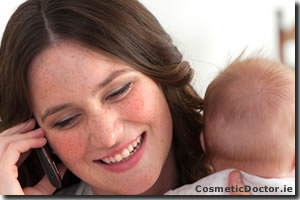…Perimenopause
If you’re in your mid-forties and have started to notice some very out-of-character behaviour from your skin, you’re probably starting to show symptoms of Perimenopause.
What is Perimenopause?
Perimenopause is a phase that occurs well before the onset of the Menopause itself. It can last for years until Menopause proper, which usually occurs between the ages of 51-54 (although can be earlier or later). Menopause is defined as being 12 months after the date of your last period, when you have stopped menstruating altogether.
Perimenopause is much more vague, as it sneaks up on you gradually, and some months you may experience symptoms like night sweats and skin issues, whereas other months you might be fine.
What are the symptoms of Perimenopause?
Changes in hormone levels and a slowdown in ovarian activity as we age define perimenopause- it’s a melange of symptoms ranges from night sweats; hot flushes; ‘brain fog’- a difficulty in concentrating; mood swings and changes to the skin.
The hormonal shifts are what cause issues in our skin; people who may never have experienced any trouble will suddenly find their skin characteristics have changed as the physiology of the skin is impacted.
Lowered oestrogen and progesterone production causes a flurry of changes and can impact women who are getting closer to menopause in the following ways:
Oily Skin: During the reproductive years, B-Estradiol stimulates a more fluid sebaceous gland secretion (“anti-acne” effect). During menopause, as oestrogen levels decrease, the presence of testosterone (produced by the adrenal glands) becomes much more obvious in the woman’s body.
Testosterone stimulates the sebaceous glands to secrete a thicker skin oil or sebum, which gives the appearance of oily skin, and a greatly increased tendency towards adult acne in many women.
Facial Hair: Also due to the ‘unmasking’ of testosterone, some women may develop facial hair, particularly in the chin area.
Sagging Skin and Wrinkles: Oestrogens are what stimulate fat deposits all over the female body. As the oestrogen levels start to drop during perimenopause, the fat deposits tend to become redistributed; often concentrated over the abdomen and/or on the thighs and buttocks.
The result is a loss of supportive fat below the skin of the face, neck, hands and arms which allows sagging wrinkles to appear. The skin loses its elasticity, and you’ll see sagging in the cheeks (causing jowls); breasts; arms; thighs and tummy.
Elastosis: Protein synthesis in the body, most notably the synthesis of collagen and elastin which keep skin taut and plump, is partially controlled by oestrogens. When perimenopause begins, the lowered levels of oestrogen results in less production and repair of collagen and elastin in the dermis of the skin.
This lack of repair is even more noticeable if the skin has been exposed to ultraviolet (UV) rays. UV rays are very destructive to collagen, and if we lose our repair mechanism, then we lose our skin’s resiliency. This results in elastosis.
Thinning Epidermis: Oestrogens also partially control the growth and maintenance of blood capillaries in the dermis. During perimenopause, the blood flow through the dermal capillaries is reduced so less nutrients and oxygen are available to the Basal Cell layers of the epidermis.
This contributes to the thinning of the epidermis and a slower cell turnover rate, which is accompanied by a reduction in the barrier function of the epidermis, leading to increased moisture loss and dry skin.
More Prone to Sun Damage: The maintenance of Melanocytes (cells that manufacture the pigment Melanin) is under the control of oestrogens. As perimenopause progresses, the number of melanocytes in the skin is reduced, and they degenerate.
With less melanocytes, we produce less of the protective melanin, so we are even more prone to sun damage and pigmentation problems.
Hyperpigmentation / Age Spots: Oestrogen exerts a regulatory effect on the production of melanin; it keeps it under control. As this regulation of melanin becomes uneven, areas of the skin that have been exposed to UV rays over the years can darken, resulting in brown “age spots” appearing on the face, hands, neck, arms and chest.
The good news is that medical technology and the advancement of skincare means that many of these symptoms can be addressed with strong skin products- for example the ZO Skin Health range from Dr. Zein Obagi. Available through doctors only, Dr. Lisa Fay of Cosmetic Doctor in Dublin has been using the range with great success for her patients, helping them to combat the more obvious skin changes resulting from hormonal changes.
To book a comprehensive skin consultation and discover the best treatment options for you to regain youthful looking, smooth skin, call Cosmetic Doctor on 01 685 3100.

